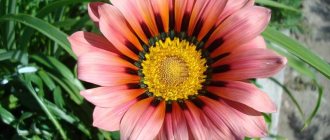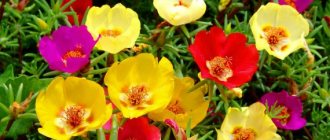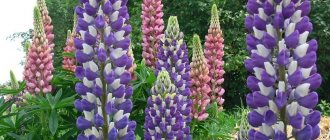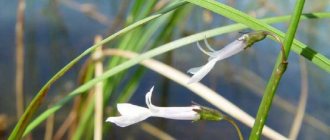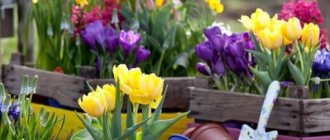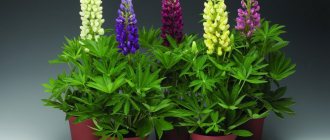Lobelia is an ornamental, beautifully flowering plant that is used to decorate local areas. The flower is demanding on growing conditions, so in our latitudes it is sown as seedlings.
Dear readers!
For you, we have created communities on social networks in which useful articles and interesting ideas are published several times a day! Subscribe and receive useful content in a convenient format! In this article we will talk about when to plant lobelia seeds for seedlings in December 2022 and in 2022.
Basic rules for growing lobelia seedlings from seeds
- Use seeds from this or the previous year of packaging for planting. Older ones may simply not germinate; they should not be planted.
- When sowing seedlings, mix the seeds with sand.
- Planting material should not be planted deep into the soil; it is better to sow superficially, otherwise the grains may not sprout.
- Choose the right soil to sow lobelia. It can be universal or for seedlings.
- If you prepare the soil mixture yourself, be sure to disinfect it by calcining it in the oven or using fungicides.
Typical diseases and pests
Viruses
The appearance of a purple tint to the leaves and uneven spots indicates infection of the crop. The disease is often confused with sunburn.
After a few days, areas of the plant will begin to deform and dry out. The stems will turn black. The plant will stop growing. It will not be possible to save the flower.
It is necessary to destroy the infected lobelia. To avoid infection, you need to regularly inspect the flower and destroy the main carrier of the virus - thrips.
Stopping the development of lobelia. Premature wilting of all inflorescences.
Bacterial disease
After a long stay in the sun, the leaves of the seedlings sharply change color to a matte shade. The shoots may acquire a brown tint.
Bacteria infect the entire plant. High temperatures and dry air contribute to the spread of the disease. The flower is affected due to the use of contaminated tools during pruning or propagation.
The pathogen Xanthomonas campestris can enter the plant through contaminated substrate or poor-quality water.
Treatment with benzoic acid will only harm the crop. An infected plant is not recommended for cuttings. Changing the container and soil will not help.
Shoot rot
Some parts of the stems become gray in color. Subsequently, mold appears. The shoots wither. Inaction can lead to infection of the entire flower.
The plant can be cured with Fengesamide or Iprodione. Damage can be prevented by increasing the level of air humidity. It is advisable to reduce feeding of lobelia with nitrogen fertilizers.
Thrips
The appearance of light marks on the foliage is evidence of the presence of dangerous insects. Pests suck out the sap of the plant. The inflorescences fall off prematurely.
Leaves and branches may become deformed and dry out. Thrips can damage the plant and also infect lobelia with dangerous diseases.
Methiocarb and Spinosad should be used to control pests.
How to determine sowing time?
The plant does well outdoors, but only in warm weather. There should be no frost after planting, as the stems and roots will quickly die. Therefore, the choice of when to sow lobelia depends on the time of year of cultivation.
It is recommended to sow lobeli for growing seedlings at the end of February. You can choose any time throughout March. Some gardeners plant in December and January. But this should not be done due to the lack of a large amount of sunlight. If you sow the seeds at the recommended time, the emerging stems will be more viable, but if the planting was done when daylight is short, then it is necessary to supplement the seedlings with light.
Choosing the right seeds is the key to successful sowing
When choosing lobelia seeds for sowing, you should pay attention to the name on the package. If it contains the word “erinus”, then you are dealing with bush lobelia; the presence of the phrase “ampelous” means that this is an ampelous (“hanging”) lobelia. Bush lobelias are distinguished by abundant flowering and grow in the form of a low spherical bush. The ampelous lobelia bush is looser and does not bloom as profusely. In addition, ampelous lobelia is quite capricious and requires certain skills to grow; even a novice gardener can easily cope with bush lobelia.
It turns out that the difficulty of growing lobelia is affected not only by its type, but also by its color. Thus, blue lobelia sprouts quite quickly and is not particularly demanding to care for, white lobelia sprouts erupt and develop more slowly, while purple lobelia is considered the most whimsical and slowest.
How to prepare planting material for sowing?
Lobelia seeds are very small. Therefore, they need to be pre-mixed with sand when you plan to sow in the soil in order to improve the germination rate. Use purchased soil or soil mixture (soil containing humus, peat, sand). Thanks to this, the seeds are fed with microelements and minerals and germinate quickly.
Granular seeds are available for sale. They are specially prepared to plant them in tablets and cassettes. If you plant seedlings using this method, you can do without picking.
Lobelia types and varieties
Lobelia is loved by flower growers for a reason: this perennial pleases the eye with its generous flowering from May almost until the first frost. There are bush and hanging varieties. The best varieties of lobelia:
- With white flowers:
“White Palace”; "White Lady". - With purple flowers:
"Crystal Palace". - With colors of blue and light blue:
“Cambridge Blue”; "Sapphire"; lobelia syphilitica. - With flowers in red, lilac and purple shades:
“Cascade Red”; lobelia cardinalis; fiery lobelia.
When to sow lobelia for seedlings in December 2022 and 2022 according to the lunar calendar?
Many gardeners use the lunar calendar to ensure that the plant germinates quickly and the sprouts do not die.
If planting on favorable days is not possible, it is recommended to sow seedlings for growing lobelia in a neutral period. The seeds will germinate at an average speed. The main thing is to avoid unfavorable dates.
Favorable days for sowing lobelia in 2022, depending on the month
The days when to sow lobelia in 2022 are indicated in the table.
| Month | Recommended dates for seedlings |
| December 2020 | 15, 16, 17, 18, 19, 20 |
| January | 14, 15, 16, 17, 18, 19, 20, 21, 22, 23, 24, 25, 26, 27 |
| February | 12, 13, 14, 15, 16, 17, 18, 19, 20, 21, 22, 23, 24, 25, 26 |
| March | 14, 15, 16, 17, 18, 19, 20, 21, 22, 23, 24, 25, 26, 27 |
| April | 13, 14, 15, 16, 17, 18, 19, 20, 21, 22, 23, 24, 25, 26 |
| May | 12, 13, 14, 15, 16, 17, 18, 19, 20, 21, 22, 23, 24, 25 |
If the gardener has time by this period, the plant will grow abundantly. The risk of sprouts not germinating during cultivation is reduced.
Unlucky days when you shouldn’t sow
| Month | Not recommended dates |
| December 2020 | 14,30 |
| January | 13, 28 |
| February | 11, 27 |
| March | 13, 28 |
| April | 12, 27 |
| May | 11, 26 |
The gardener must miss any given date. This does not mean that there will be no sprouts. They may be thin and non-viable.
When to plant depending on the region
Shoots
Different territories of Russia have their own climate. For example, in the north it is arid and cold. If you plant closer to the south, less care will be required, since the soil in this part is fertile and the climate is favorable.
- Northern parts (Ural, Siberia). It is better to plant lobelia at the end of February.
- Kaliningrad region. This part has not only a cold climate, but also abundant humidity. Therefore, the time to sow lobelia is moving towards the end of February - beginning of March.
- Middle zone (Moscow and Moscow region). Seeds are rarely planted in February because they may not germinate. It is preferable to sow lobelia in March.
- Southern part of Russia. The climate is mild. Spring and summer are long. Therefore, lobelia seeds are planted at the end of February. This can be done directly in open ground, since frosts are rarely observed after March.
Weather conditions greatly influence germination. Make sure there is no frost. The time of appearance of the first stems is influenced by the variety and variety of the plant. For example, ampelous lobelias grow more slowly than others; it is better to sow them in advance.
Lobelia: caring for an adult plant
Lobelia has a peculiar character, knowledge of which will prevent you from many failures and disappointments associated with growing this flower.
The most destructive thing for lobelia is drought. Lobelia should be watered frequently, avoiding long drying periods, especially in the summer heat. On such days, its leaves quickly burn in the sun, the stems turn yellow and dry. Naturally, not only the decorative appearance suffers, but also the health of the plant. Often lobelia does not withstand such tests and after regular drying or a one-time, but long-term drought, it dies.
At the same time, lobelia is not very favorable to stagnation of water near the roots. Therefore, when planting it in a pot, you need to take care of the presence of drainage holes and a drainage layer at the bottom.
Another scourge for lobelia is the summer heat, from which in July there is often no escape even in shady areas, northern windows and balconies. As a result, yellow and dry leaves appear on the plant, which have to be plucked or cut.
Just in the middle of summer there is a period of weakening of lobelia flowering. The stems become elongated and turn yellow, and flowers rarely appear. The problem is solved by radical pruning, after which the second wave of flowering begins. Trim the lobelia, leaving about 5-10 cm, after which the bushes grow into a lush cap and bloom again after 2 weeks.
The reason for weak flowering, in addition to heat and drought, is often unsuitable soil - rich in organic matter or nitrogen mineral fertilizers. Therefore, during the flowering period, lobelia needs fertilizing with a minimum of nitrogen. Or without it at all. Lobelia is very responsive to fertilizing with potassium sulfate. Against its background, the flowering is so abundant that greenery is not visible among the flowers.
Lobelia in a balcony box is an unforgettable sight!
The basic rules for caring for lobelia are:
- Minimum of direct sunlight, maximum of bright diffused light.
- Abundant watering, but without stagnation of water at the roots.
- Periodic fertilizing with fertilizer for flowering plants.
- In mid-summer - drastic pruning for the second wave of flowering.
Planting lobelia seeds step by step
Sowing is easy to do. To do this you need to follow these steps:
- a hole is first made in the container for drainage (you can buy ready-made pots);
- soil is placed in the container, compacted, watered (to ensure rapid germination, various water additives are used, for example, phytosporin);
- Place a handful of seeds on the paper and fold it into a corner;
- lightly tapping the paper, carefully distribute the seeds in the ground;
- It is prohibited to place earth on top;
- spray the scattered seeds from a spray bottle with a very weak solution of potassium permanganate;
- the container is covered with glass on top, for example, a jar, bag or transparent film;
- Place the container in a warm place.
Depending on the gardener’s preferences, soil for growing can be purchased ready-made or made independently. Some people add vermiculite to the soil. This is a product that increases the porosity of the soil, which allows a large amount of oxygen to pass inside.
Watering and diving the plant
When you notice that the seedlings have begun to hatch, immediately move the containers to the brightest place in your apartment. The seedlings should be carefully watered daily. Carefully inspect the plants; at the first signs of any diseases, damaged shoots should be removed and the soil should be treated with a fungicide.
Since the container in which the seeds are planted is covered, condensation collects on it and additional moisture is formed. To avoid the appearance of mold and various diseases of seedlings, you need to regularly ventilate, open the lid for at least 20 minutes twice a day.
Watering rules
At first, after the seeds germinate, you need to water the plants as the soil dries out. When the seedlings have already grown stronger and you will not cover them, you will need to irrigate much more often. As soon as the soil hardens, immediately moisten it so that the sprouts do not disappear, since their root system is weak. No feeding is needed at this stage.
Picking seedlings
This procedure is necessary when you want to transplant it into a common container. The sprouts are planted in bunches containing from five to ten plants. Before planting lobelia, you should remember that this must be done as carefully as possible. It is most convenient to perform this procedure using a teaspoon. All actions must be extremely precise, since it is easy to damage the root system of the plant.
Transplantation is carried out approximately three weeks after the first shoots. For this, use small disposable cups with a diameter of up to five centimeters, or drawers. The distance between the sprouts should be about 5 centimeters. You need to act as carefully as possible, since the seedlings are very thin and fragile. Try not to damage them.
The first blooms of lobelia after sowing can be observed after 2.5 months.
Several seedlings should be planted in one container, since it is almost impossible to separate them one by one. Any attempt to do this poses a great danger of harming the plant. Make a small hole in the soil, place the seedlings in it, lightly press down with soil and water. All you have to do is be patient and wait until the seedlings grow a little.
How to care for lobelia seedlings, what tricks
There are basic rules that gardeners follow for better germination of lobelia seeds. If you follow them, the risk of plant death is reduced.
Lobelia seeds have sprouted, what to do next?
The first stems appear after 7-10 days. They are thin and susceptible to adverse environmental conditions. Immediately after the emergence of lobelia shoots, the following care is required.
- Watering. Lobelia is not a moisture-loving plant. Therefore, you need to water in moderation, but without waiting for it to dry out. Use settled water at room temperature. Hot or cold liquid will damage the sprouts and root system. If overwatered, rotting will begin and the lobelia will die.
- Lighting. Light should fall on the seedlings when growing indoors, but direct rays are completely avoided. Burning of young stems may occur. Lighting should be natural. Daylight hours are at least 12 hours a day.
- Temperature conditions. Optimally it should be 20-25 degrees. Then the sprouts will appear earlier.
These are the minimum requirements for growing seedlings at home.
Watering seedlings
How to feed lobelia seedlings
Apply water-soluble, mineral fertilizers. They must be of low concentration in order to be beneficial, but not harmful. For feeding, you can use a solution of Fitosporin, Biohumus or any other liquid fertilizer. You can find out the dosages from the instructions.
Picking rules
Picking must be done carefully. This is due to the weakness of the root system and stems. It is recommended to follow the following steps:
- select 5-10 pieces of regrown sprouts;
- transplanted into a separate container;
- expect several leaves to appear.
Pinching is not done until 5 true leaves are formed.
Picking
Pinching lobelia
Pinching can be used for bush varieties; it is not used for hanging varieties. Pinch off the sprouts when they have formed 5-6 true leaves. This procedure is done so that the flowers branch better.
Methods for sowing small lobelia seeds step by step with photos and videos
Let us immediately note that you should not worry about the fact that you will need to distribute small flower seeds over the surface of the soil at a certain distance from each other. Seedlings can grow in heaps, since they plant lobelia not one sprout per glass, but in bunches. This makes it easier to grow lobelia from seeds at home. However, it is not recommended to sow too thickly. Therefore, we offer planting options that will help you get friendly and not very dense shoots.
Attention! Lobelia seedlings can be planted in a common container followed by picking or in separate cups. In the latter case, there is no need to pick the plants.
Sowing in the snow
A very quick way to plant tiny lobelia seeds is to sow them in the snow. You only need to prepare a container, soil for seedlings and snow. The soil does not need to be pre-moistened. The snow is spread over it in an even layer and compacted a little.
The seed can be sprinkled on the snow, rubbing it between your fingers, or you can “dip” your finger into the seeds first and then run it across the snow. Dark seeds are clearly visible on white snow. If it seems to you that they are lying somewhere thickly, you can correct the situation with the help of a toothpick.
Watch a video that shows how easy it is to sow lobelia seeds in the snow.
Sowing with sand
When planting in the spring, in many regions there is no longer snow, so sand can be used to sow lobelia seeds for seedlings. We’ll tell you step by step how much sand you need for this sand and how to sow small seeds with it correctly with photos:
- Prepare containers with drainage holes.
- Pre-moisten the soil for seedlings. If you bought it in a store and just opened the package, then the soil in it is quite moist.
- Pour soil into a container or glass so that there is 2-3 cm left to the edge.
- Pre-heat the dry sand in the microwave, cool and mix thoroughly with the seeds. You need to take about two tablespoons of fine sand per bag of planting material.
- Spread the mixture evenly over the surface of the soil.
- Using a spray bottle, carefully spray the plantings with lukewarm water.
- Cover the container with a lid or cling film and place in a warm place.
It is important! After sowing, there is no need to sprinkle lobelia seeds on top with soil or sand, no matter how you sow them.
Before emergence, plantings should be in a warm place. The containers can be placed on a warm floor or radiator. But be sure to cover the heating radiator with a folded towel, otherwise the seeds in the soil will simply “cook”.
You will be interested to know: Heliotrope: growing from seeds, when to plant seedlings, planting and care in the garden
If there is no sand or snow, no problem. Simply, rubbing the seeds between your fingers, try to sow them evenly over the surface of the moist soil. After this, also spray, cover and put in a warm place.
Another way to plant lobelia seedlings without sand, but it’s very simple, watch the video clip.
Planting in peat tablets
It is very convenient to sow and grow lobelia seedlings without picking in peat tablets. It grows in them before planting in the ground or flower pots. There is nothing complicated about sowing small seeds into peat tablets:
- Place the tablets in a deep container and pour warm water into it.
- After about 20-30 minutes, the peat will be completely wet, and it will be possible to begin planting work.
- To do this, you just need to dip your finger in the lobelia seeds, and then smear them, that is, sow them on top of the peat tablet.
- Cover the container with a lid or film and place in a warm place.
Attention! Before emergence, check the moisture of the soil, especially peat tablets, every day. It is also necessary to remove the cover to ventilate the soil and check whether seedlings have appeared.
Watch a video about sowing pelleted lobelia seeds in peat tablets.
How to plant correctly in open ground?
When planting seedlings, take the sprouts together with a lump of earth so as not to damage the root. Place the plants themselves at a distance of 15-20 cm from each other so that they have room to develop.
Don't forget to water the seedlings with a little water. If the weather is too sunny and hot, then install a shelter. For example, from tree branches with leaves.
IMPORTANT! Landing must be done on a cloudy day in the morning or evening.
Lobelia pick
Seedlings grow in about a month. Lobelia is picked not one plant at a time, but in groups at once. Use a small spatula to pry up the bush and transplant it into a glass. If the seedlings grow like a carpet, then separate part of the soil along with the seedlings and transplant them into larger containers. After picking, the plants are watered and kept in the shade for several days, after which they are again placed in a sunny place.
Interesting Facts
Interesting facts that a novice gardener may not know:
- caring for an annual or perennial plant is similar;
- if perennial varieties are selected, dry inflorescences are removed every year in the fall so that the next flowering will be abundant;
- the bushes are pruned into a ball shape;
- if the local climate is warm, wintering is also possible in flower beds; in the northern regions it is recommended to grow the plant in large containers, changing their location depending on the ambient temperature;
- Lobelia is used in landscape design, grown in hanging baskets, decorative flowerpots, and flower towers.
When flowering occurs, large balls of bushes are formed that resemble clouds.
Reasons for the absence of inflorescences
Abundant flowering can be ensured only by observing all agrotechnical growing conditions.
After flowering, seed pods form on the lobelia.
There are several rules for successfully stimulating the formation of buds:
- A brightly lit landing site.
- Air-permeable and drained soil.
- Water as needed.
- Pruning dry and damaged stems. After flowering, bare shoots must be removed.
- Periodic pinching.
- A sufficient amount of fertilizing without nitrogen components.
Large inflorescences on low-growing bushes are formed on lobelias grown from English seeds. It is advisable to plant terry lobelia in the ground directly in a shipping container. In the fall, you can remove the pot from the ground and move it indoors.
Answers to frequently asked questions
Gardeners are often interested in questions about growing flowers at home. However, there are some that are the most common.
What soil should I buy for growing seedlings?
It is better to buy a ready-made soil mixture that contains all the useful substances. It should contain humus, peat, sand.
How can you stimulate seeds for further growth?
They use mineral liquid fertilizers, but it is better to wait until transplanted into open ground and fertilize already there.
Why don't the seeds germinate?
Seeds may not germinate due to lack of moisture and sunlight; if planted in open ground, then frost could interfere, and lobelia may not germinate due to pests and infectious diseases. For successful germination, all environmental factors must be stable.
Why soak seeds?
Soaking is used for rapid germination. When the seeds are moved into the ground, stems appear instantly (within a few days). The risk of developing diseases is reduced.
How to harden lobelia seedlings?
The hardening procedure is carried out after the dive, when the plants begin to gain strength. Flowers are taken out into the fresh air in favorable weather, first for 1-2 hours, then the time is increased. This will give the stems and leaves a chance to acclimate to the changing temperatures.
What to do if lobelia seedlings do not grow?
It is recommended to check the soil moisture. It should be moderately saturated with liquid. Do not overdry or overfill. The container with lobelia seedlings is placed on the windowsill so that the sun hits the soil. But there should be no open sunlight, otherwise the sprouts will burn. You can add a small amount of mineral fertilizer. The substance is first diluted 2-3 times.
Preparation for the sowing procedure
For further sowing, you will need to prepare the soil and container.
What primer should I use?
For lobelia, you need to prepare the soil. The flower loves soil with the following characteristics:
- ease;
- looseness;
- high air and moisture permeability;
- neutral acidity.
It is better to purchase soil in a store, since it already has all the above qualities, so it will free you from unnecessary worries. You
can prepare the soil yourself from soil, humus, river sand and peat in a ratio of 2:2:1:1.
If the soil is highly acidic, it is necessary to add a small amount of wood ash or dolomite flour to it before planting. These components are capable of neutralizing acid.
Before sowing, it is important to disinfect the soil using high temperature. To do this, place in the oven for half an hour, maintaining 90 degrees. Then hold it over steam for 60 minutes.
Selection of capacity
You can sow lobelia in any container; there are no strict requirements for choice. The main thing is that it is spacious and not too deep. Flower growers purchase special containers in stores or adapt something at hand.
The following options are possible:
- wooden boxes;
- plastic cups;
- peat cups or tablets;
- plastic cassettes;
- flower pots.
At home, you can make a wide variety of containers with your own hands, you just have to show your imagination
It is important that the bottom of the container has holes for drainage. They are not required only when using peat cups and tablets.
